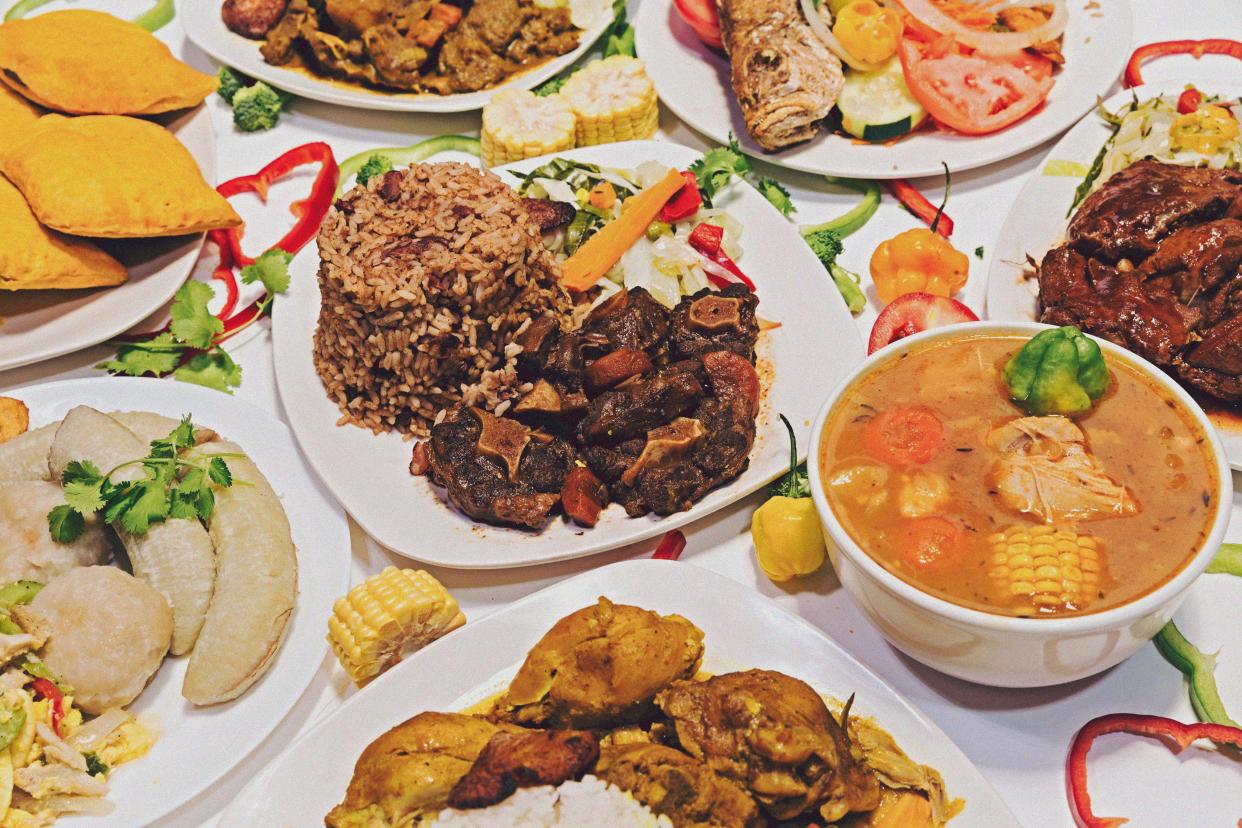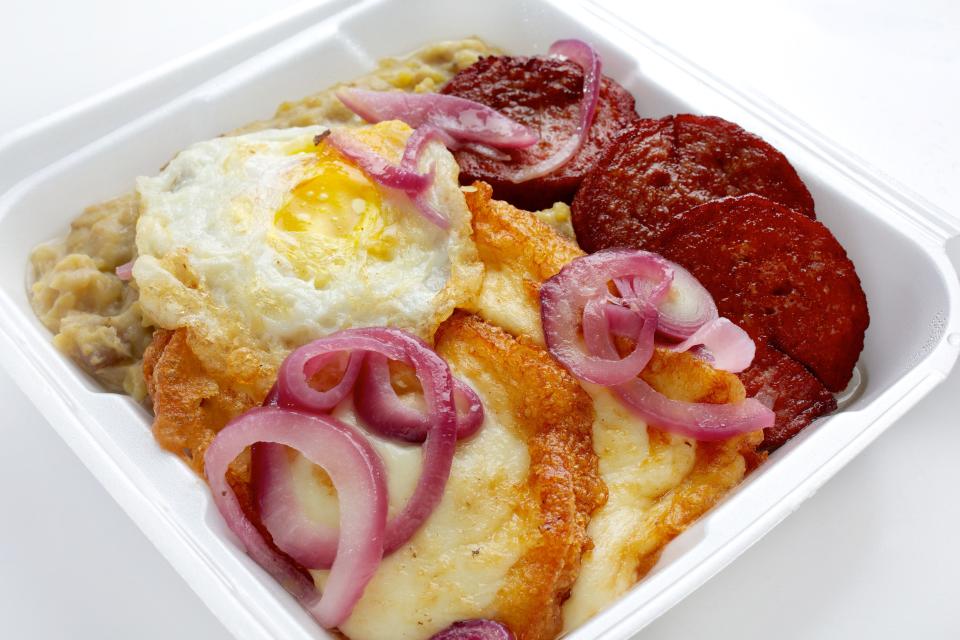Caribbean Food Is Powerful Enough to Be a Peacemaker

Getty Images
This feature on the mediating power and unifying significance of Caribbean food, by Tenille Clarke, belongs to a package celebrating Caribbean Heritage Month. Throughout June, we will honor the powerful creativity, ambition, and heart of Caribbean culture through the sharp perspective of writers of Caribbean descent. The Caribbean is not just a tourist destination — it is a region, a people, and an identity rich in history and spirit.

caribbean heritage month banner
Art Treatment by Kaitlyn McNabOne sunny August afternoon when Gissel Alvarez was young, she quietly stepped into the hollowed archways of her grandmother’s kitchen to make a culinary peace offering: tres golpes.
Made with salami, fried cheese, fried eggs and mangú, the classic dish is considered the “Breakfast of Champions” for many Latin-Caribbean families in the Dominican Republic. For Alvarez, whose parents are from the tobacco hub of Villa Gonzales, this particularly tense occasion required a comfort meal, one familiar and made with special love and care.
“My grandfather’s health was declining, and it was time to speak to my grandmother about the next steps,” Alvarez recalls. As she chopped red onions and watched the light dance against the sharp, steely blade, she heard a soft, maternal voice behind her: “You don’t have to bring out onions to mask your tears.”
It was at that point that Alvarez knew that her abuela was finally ready to face the reality she had avoided for months. “The news was being brought to her in the best way she taught me: with food and in the kitchen," says Alvarez. "It was the toughest conversation to have because as husband and wife, they had been married for over 50 years. Ultimately, we laughed, cried, and hugged it out while having a hearty meal to conquer this new chapter in our lives.”

International breakfasts - Los Tres Golpes from Los Hermanos Dominican Restaurant
In that moment of clarity, Alvarez drew on food’s ability to provide solace, a technique embedded in her own cultural roots. As people, we tend to turn to our home-cooked meals in dark times, a coping mechanism that’s particularly utilized by those of Caribbean heritage — because Caribbean food was born from innovation, survival, and periods of adversity. It plays an important role in preserving our cultural identity, connecting our families, and lending us strength when times get tough.
For centuries, Caribbean food has been crucial in consoling us through despair; its gastronomic history illustrates why. Caribbean food intersects with race, colonialism, and class, and many popular Caribbean dishes we know and love today were, in fact, born from slavery.
Trinidad and Tobago-born Dr. Gabrielle Hosein, a senior lecturer at The University of the West Indies (UWI), St. Augustine, says that Caribbean food tells stories known and unknown.
“Plants, spices, and seasonings were brought by Indians who came to the Caribbean as indentured workers between 1838 and 1917 and were carried in their small wrapped belongings, what were called jahaji bandals [ship's belongings] or 'georgie bundle' in the creole Caribbean today,” Dr. Hosein says. “So Caribbean food is the story of those cuttings and seeds journeying across both oceans and empire, and becoming part of now-familiar dishes created and popularized in the new world.”
The plants and spices originally offered a connection to the indentured workers’ homeland, and eventually evolved into staples of a new culture and region. For instance, take Doubles: a popular Trinidadian street food made from chickpeas, or channa, with mango, cucumber, tamarind, and hot pepper served between fried handfuls of billowy dough. Mango, tamarind, and cucumber were all brought over in jahaji bandals. Other traditional Trinidadian dishes of the French West Indies, like Pelau, share similar roots.

In the wake of the Transatlantic Slave Trade and indentured servitude, Hosein says that women would grow their own food and sell their own produce, including milk, to provide for their families and “survive empire.”
Given the fact that our ancestors used food not just as a means of survival, but as a link to their homelands during a devastating era of strife, abject poverty, and oppression, it then makes sense that we might draw on this food in a modern context to act as a salve.
Grenadian restaurateur Abi Singh often has difficult conversations over food. “I think the most powerful quality of food is its ability to improve your mood, whether by just the way it’s presented or how it tastes,” says Singh, who is the co-owner of Punj-Abi restaurant, an establishment that fuses the cultures and flavours of Northern Indian and Afro-Caribbean food, with her husband Dr. Vajinder Singh.
In her view, Grenada’s national dish, Oil Down, is a classic example of this. “You would find many variations of [Oil Down] depending on who makes it, their food and taste preference — yet the mixture of colours and the taste of spices and coconut immediately calms you and you want to enjoy every bit of it," says Singh.
According to Singh, there is one major distinction in the ways that Caribbean people use food as a mediator versus other cultures — she's observed the differences firsthand through her partner’s East Indian community. “I’d say the difference is that on [the Caribbean] side, there is a plan to meet, eat, and talk," she laughs. “On the other side you meet, talk, then eat.”
In Jamaica, the community-binding spirit of food is brought to the forefront during periods of bereavement. The island’s nine-night tradition is a popular and storied celebration of a deceased person's life. There's dancing, singing, dominoes-playing, and disc jockey sound-system setups for communal entertainment — but food plays perhaps the most major role in the event.

Jamaican Curried Goat
“It's customary for an array of dishes to be prepared with the help of family and friends," explains food influencer Jody-Ann Williams, "Which include curry goat with white rice, mannish water also known as goat head soup, fried chicken, rice and peas, fried sprat served with bread, and other items contributed by family and friends, like a pig or a cow that would be cooked to serve at different times when there are visitors."
Other mourners attend the (hardly) somber occasion for the rum, Williams notes, which some guests would even pour out as libation for the dearly departed. For Williams, Caribbean food is a pervasive reminder of the importance of sacred family relationships, like the one she shared with her uncle Markland Williams.
“I have a picture of him and I as my cell phone wallpaper, and in that image he’s feeding me banana chips as a child," remembers Williams. “When he was alive, we would always talk about what we would eat for breakfast, lunches, birthdays — and one of our favorite meals to share would be stew peas.”
In his memory, Williams now commits to eating stew peas every Wednesday. Her preservationist approach to food is an honest trademark of her continuing grief, a representation of the solemn impact of her uncle's passing, and an archival method for her to safeguard Caribbean food traditions while memorializing her uncle’s life. Williams is the creator of popular food blog Where's The Food, Jo?
“These are the delicious stories that uphold cultural identity, foster community bonds, attract tourism, support local and regional economies, and offer healthier dietary options using natural, locally sourced ingredients," says Williams.
Whether you identify with the longstanding customs of the Spanish, English, French, Dutch or Indigenous Caribbean, exploring cultural foodways is an integral part of the region’s daily communal traditions. Difficult conversations have long been a part of the global human experience, and our shared heritage in the preparation and sharing of meals act as a bridge between healing and hardship, or differences in opinions. Caribbean food is a peacemaker, and a special reminder that food will always be the greatest social equalizer.
Originally Appeared on Teen Vogue
Want more great Culture stories from Teen Vogue? Check these out:
A New Generation of Pretty Little Liars Takes on the Horrors of Being a Teenage Girl
Underneath Chappell Roan’s Hannah Montana Wig? A Pop Star for the Ages
Donald Glover’s Swarm Is Another Piece of Fandom Media That Dehumanizes Black Women
On Velma, Mindy Kaling, and Whether Brown Girls Can Ever Like Ourselves on TV
Gaten Matarazzo Talks Spoilers, Dustin Henderson, and Growing Up on Stranger Things
How K-pop Stars Are Leading Mental Health Conversations for AAPI People and Beyond
Meet the Collective of Philly TikTokers Making You Shake Your Hips
The Midnight Club Star Ruth Codd Isn’t Defined By Her Disability


